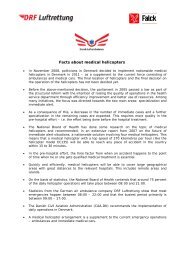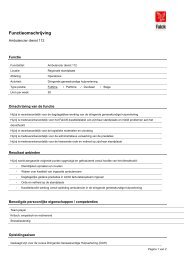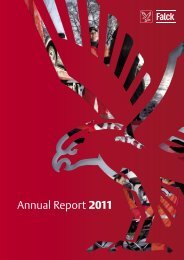Annual Report 2010 - Falck
Annual Report 2010 - Falck
Annual Report 2010 - Falck
Create successful ePaper yourself
Turn your PDF publications into a flip-book with our unique Google optimized e-Paper software.
Notes to the Group financial statements<br />
Note DKK million<br />
36 Financial instruments (continued)<br />
Group | <strong>Falck</strong> <strong>Annual</strong> <strong>Report</strong> <strong>2010</strong> 91<br />
Interest rate risk<br />
The Group’s interest rate risk is mainly affected by the Group’s overall financing. Based on the current market situation, the Group's<br />
Executive Management Board and Board of Directors have resolved that the financing is to be based on short-term interest rates. The<br />
Group is therefore sensitive to fluctuations in market interest rates, and a fluctuation by 1% would change the interest expense for the<br />
year by DKK 13 million (2009: DKK 10 million) as the market rate for the current year is below the floor of interest rate collars. Without<br />
an interest rate collar, a fluctuation by 1% would change the Group's interest expense by DKK 34 million (DKK 29 million).<br />
The Group monitors developments in market interest rates closely so that it can react if the market situation changes.<br />
In order to hedge interest rate risk, the Group has entered into an interest rate collar which hedges a substantial part of the increased<br />
interest exposure if market interest rates exceed 5.5%. The interest rate collar also includes a floor rate fixed at 3.25% and thereby resulting<br />
in the hedged amount at all times being subject to interest in the range of 3.25% to 5.5%.<br />
Assumptions regarding sensitivity information:<br />
The sensitivity stated has been determined based on the recognised financial assets and liabilities as at 31 December <strong>2010</strong>. No adjustment<br />
has been made for servicing and raising of debt, or the like in <strong>2010</strong>. Furthermore, it is assumed that all hedges of floating-rate<br />
loans are effective.<br />
Credit risk<br />
The Group’s credit risk primarily concerns primary financial assets. Credit risk related to financial assets equals the values recognised in<br />
the balance sheet.<br />
The Group is not exposed to significant risks concerning individual customers or business partners. When entering into significant contracts,<br />
the Group makes a credit assessment of the customer in order to reduce the potential credit risk. The Group’s credit exposure to<br />
large customers is generally considered to be low as the Group’s large customers are typically public authorities.<br />
Subscription sales to private and corporate customers are not deemed to involve material risks to the Group as the amounts are small for<br />
the individual subscriptions, and general as well as individual provisions are made for anticipated bad debts. As at 31 December <strong>2010</strong>,<br />
receivables from such subscrioption sales were in the region of DKK 76 million (2009: DKK 45 million).<br />
Liquidity risk<br />
The Group’s liquidity risk primarily concerns its ability to meet its obligations to pay its employees and creditors and to service its debts.<br />
See note 27 for a breakdown of maturities of liabilities to credit institutions. In addition to its recognised liabilities, the Group also has<br />
the option to draw on short-term credits.<br />
The Group continuously monitors its free cash flow in order to assess its liquidity risks.<br />
At year-end <strong>2010</strong>, the Group’s unused credit and other facilities were at the level of DKK 720 million (2009: DKK 542 million).<br />
With the addition of available cash and cash equivalents of DKK 745 million (2009: DKK 625 million), total cash resources were at the<br />
level of DKK 1,465 million (2009: DKK 1,167 million).<br />
Certain of the Group’s loans, including the debt of <strong>Falck</strong> A/S, are subject to certain loan covenants, and the Group continuously monitors<br />
whether the covenants are observed.<br />
Derivative financial instruments recognised in the balance sheet are stated at a value equivalent to the market value.
















